Ferns are generally low-maintenance plants, providing elegant beauty with minimal fuss. But sometimes, despite our best efforts, some of the fronds of the fern can turn brown and die back – disfiguring the plant and causing concern about its health. This raises the question: should you cut back the brown leaves to protect your ferns?
Cutting back brown fronds is good practice, and almost always benefits the plant. As well as improving the appearance of the fern, it reduces the risk of disease and stimulates new, healthy growth. However, it is important to understand why the fern has turned brown so that you can protect against future damage, and keep the plant healthy and vibrant in the long term.
The best way to fix ferns that are suffering with brown fronds is to cut back to near the crown to make way for new growth. But before grabbing your shears, it is important to understand what caused the damage in the first place, so that you can solve the problem for good, rather than simply making cosmetic improvements.
Why do ferns turn brown?
There are many potential causes for ferns to turn brown and lose fronds. Some are natural and no cause for concern, but others indicate a problem with how the fern is coping in its habit. Here are some of the commonest reasons why ferns can turn brown.
1. Dry soil
Many species of ferns are sensitive to drought. The majority thrive best in moist, well-drained soil. If the soil dries out too much, this can cause the fronds to wither, and eventually turn brown. Usually, too little water results in the tips of the frond browning first, but eventually it can lead to the whole frond turning papery and looking dried out. Drought damage tends to be even across the plant, with fronds at both top and bottom suffering from brown tips and edges.
Fortunately, this is an easy problem to solve. If the soil at the base of the fern feels dry, it needs a water. Often it is best to do this in stages – allowing the first dose of water to be well absorbed before topping up, rather than soaking in one go. The goal is to keep the soil damp, but not waterlogged, at all times.
For busy (or forgetful) people, it is possible to set up self watering pots or planters as a precaution against future oversights.
2. Sun scorching
Too much direct sun can also be damaging to ferns. Although some species are tolerant of sun, others need full or partial shade to survive. Sun damage often appears as the fronds looking bleached out and brittle.
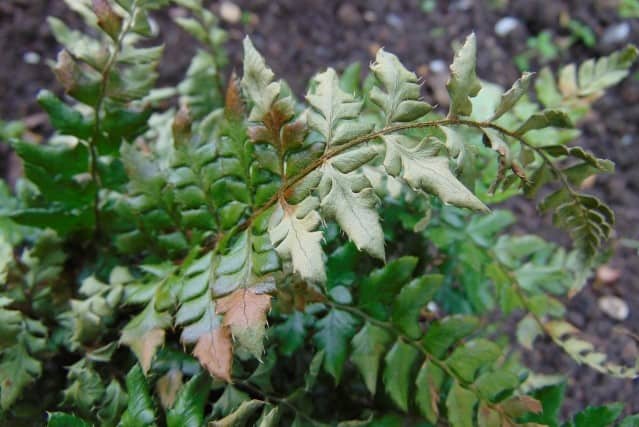
The solution to this problem is to provide more shade. If the fern is indoors, move the pot away from windowsills and into the room. For outdoor ferns, you can either replant in a more naturally shady place, or increase the cover around the existing spot with new planting or hard landscaping.
3. Wind damage
As a general rule, ferns like shelter. Too much wind will decrease the humidity around the plant, and lead to dehydration. This can even be an issue in the house, if the fern is positioned near a draft.
The symptoms will be similar to those of drought, although the browning may be on one side of the fern that is more exposed to the draft, rather than more evenly spread.
Outside, serious gusts can also cause physical damage that breaks the fronds, causing them to brown.
4. Physical damage
It is not only wind that can cause physical damage, of course. Some ferns can be prone to bruising if the fronds are handled too much or brushed against repeatedly (on the edge of a path say, or by an open doorway). Pets and wild animals can contribute to this problem.
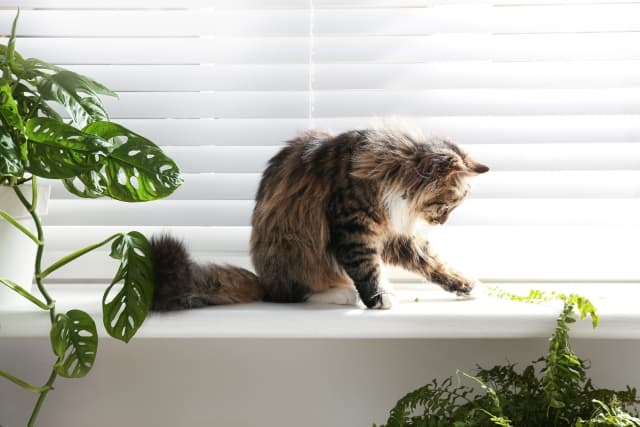
All that can be done to protect against this kind of bumping and brushing is to either move the fern, or prune back the fronds more assertively to clear any growth that is overhanging walk ways. And to resist the urge to stroke sensitive ferns, however tempting it is to run your fingers through the delicate foliage.
5. Overwatering
It might seem as though there is a Goldilocks rule for indoor ferns, because overwatering can be as big an issue as underwatering – but the simple rule is damp but not soggy. Signs that your fern is overwatered are: wet soil that does not drain well, yellowed, wilting fronds, and an unpleasant, musty smell. Another sign is that the pot seems heavy when lifted, because the soil is waterlogged.
Waterlogging can cause root rot, which will need to be dealt with. To find out how serious the problem is, carefully take the fern from the pot and turn the root ball upside down. Look for blackened, mushy roots, which are a sign of rot, and cut them away with clean pruning shears or secateurs. It is best to repot the fern into fresh potting compost, with coarse sand or grit mixed in to improve drainage. Make sure the new pot has good drainage too, using crocks or polystyrene to keep the hole in the base clear. Wash off as much of the old soil as possible before replanting, so you do not carry over the fungi or bacteria that were causing the problem.
For outdoor ferns, waterlogged soil is obviously harder to deal with. Some ferns thrive in marshy conditions, so if you have a boggy area in the garden your best bet is to relocate any ferns that struggle and replace them with more suitable varieties. Here are a few good choices:

Ostrich fern
- Matteuccia struthiopteris
- Deciduous
- Full or partial shade
- Height: up to 1.5 m
- Soil: acid or neutral. Moist, well-drained.
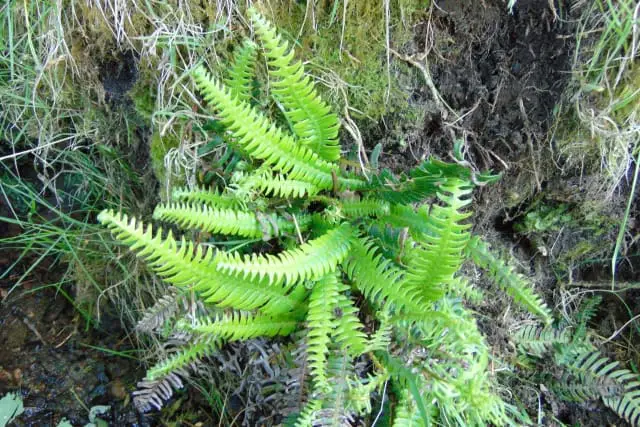
Hard fern
- Blechnum spicant
- Evergreen
- Prefers partial or full shade
- Height: up to 0.5 m
- Soil: acid or neutral. Moist, poor-drainage tolerated.
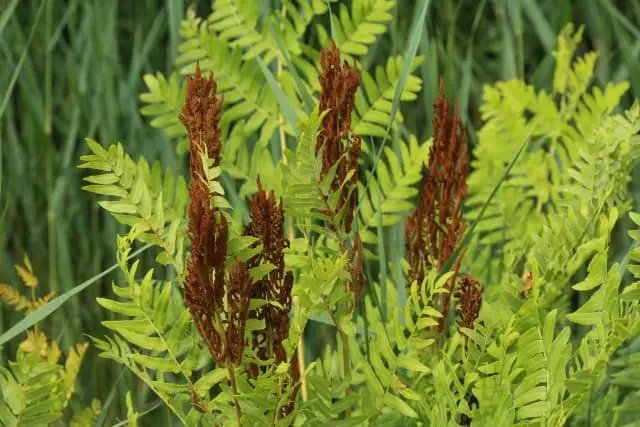
Royal fern
- Osmunda regalis
- Deciduous
- Full or partial shade, and full sun
- Height: up to 2.5 m
- Soil: acid, neutral or alkaline. Moist, poor drainage tolerated.
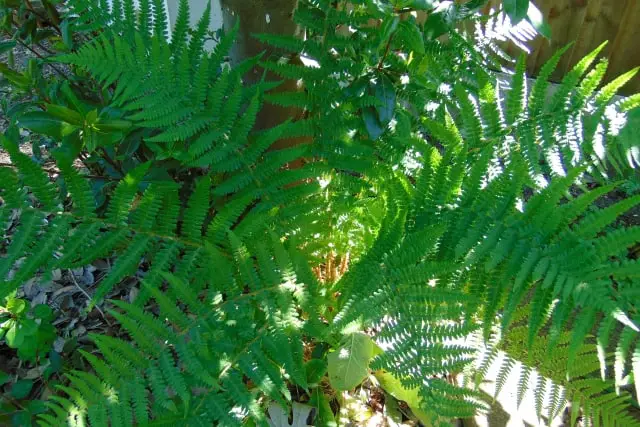
Male fern
- Dryopteris filix-mas
- Deciduous
- Prefers partial or full shade
- Height: up to 1.5 m
- Soil: acid, neutral or alkaline. Moist, poor drainage tolerated.
6. Too much fertilizer
Another risk with indoor ferns is overenthusiastic use of fertilizer to encourage growth. This can unfortunately backfire, as ferns need little in the way of supplementary feeds, and too much fertilizer can be harmful. Browning at the tips and edges of the fronds in ferns that are kept in otherwise ideal conditions for light, water and humidity, could be a sign of overfeeding. In severe cases, overfertilizing can damage roots and stunt the growth of the fern.
The obvious solution is to stop fertilizing the ferns for a while, but it is also a good idea to either repot into fresh soil or rinse the current soil well until the concentrated salts and minerals are cleared.
7. Pests
A less common cause of brown fronds for either indoor or outdoor ferns is pest damage. There are a number of common pests that can infest ferns, including spider mites, scale insect, mealy bugs and aphids. Pest infestations can sometimes be seen with the naked eye, but other indicators can be sticky webbing on the frond, discoloration, and wilting despite good watering.
Infestations should be dealt with in the same way as for any other houseplant. Washing with soapy water and rinsing can be sufficient in some cases, but more serious problems can call for insecticides. It is also important to keep infested ferns away from other plants until the problem is solved.
Finally, fungal infection can also be an issue. As with root rot, it is best to clear any infected fronds and roots from the plant (and destroy, rather than compost, the infected waste), before cleaning and repotting the fern. Again, in persistent or serious cases a fungicide might be necessary.
8. Old growth
Having covered all the ways that ferns can turn brown due to injury or insult, we finally need to consider cases where there is no harm or damage to the plant – the browning is simply part of the normal growth cycle of the fern.
In the first instance, it may simply be that the plant is reaching a ripe age, and some of the older fronds are exhausted and dying back as the new fronds burst forth and spread over them. This usually appears as brown or yellowed fronds at the bottom of an otherwise healthy and vibrant plant.
It’s natural that even robust evergreen ferns will have some die-back of old fronds with age. The simple solution is to simply prune back these older parts of the plant to highlight the new growth.
9. Deciduous ferns
The last case to consider is that the fern is a deciduous variety that always turns brown in fall and winter. This is of course natural and does not need attention – you can simply enjoy the beautiful autumn display. Similarly, some ferns have natural bronze foliage that is bred to be admired, not pruned.
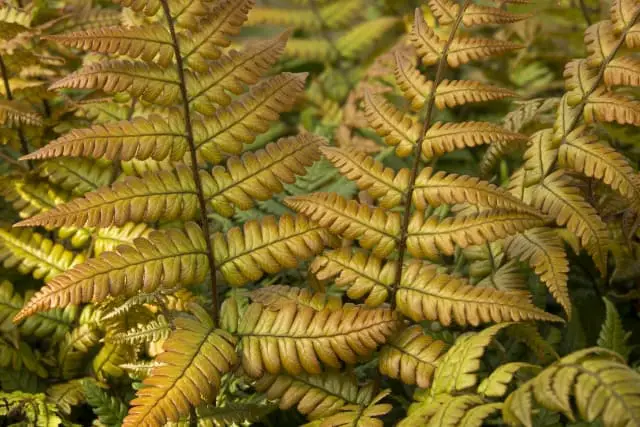
Sunset fern
- Dryopteris lepidopoda
- Semi-evergreen
- Full or partial shade
- Height: up to 1 m
- Soil: acid or neutral. Moist, well-drained.
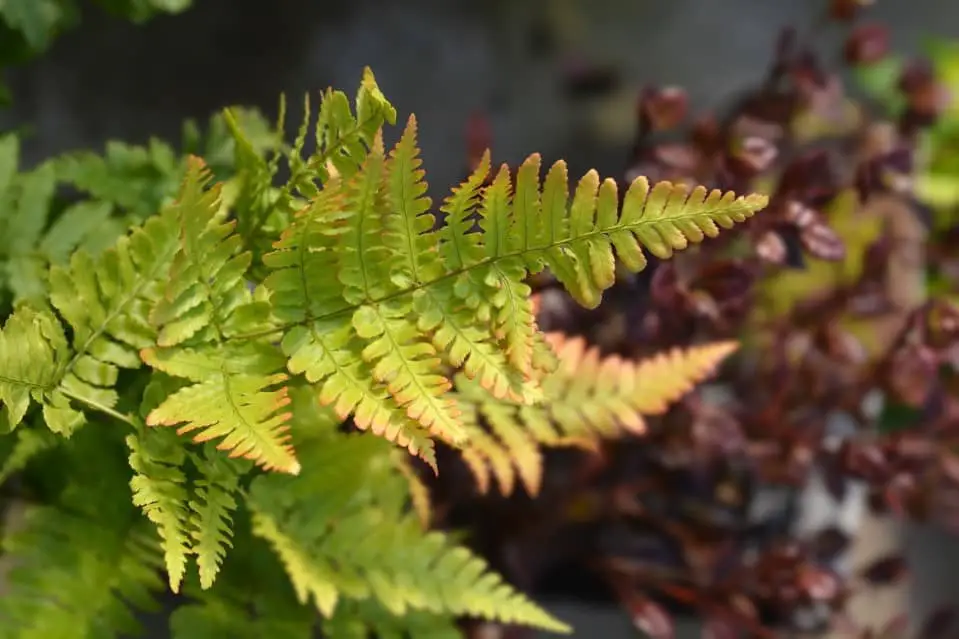
Autumn fern
- Dryopteris erythrosora
- Semi-evergreen
- Full or partial shade, and full sun
- Height: up to 1 m
- Soil: tolerant of most pH and drainage conditions.
For deciduous ferns, it is not urgent to clear brown fronds in the winter. The dead fronds can be beneficial for mulching and soil enrichment, and pose little threat to the plant. In spring, routine maintenance can be carried out to make way for the new fiddleheads that will emerge.
How to cut back dead fronds
Once you have identified the likely cause of the problem, the procedure for clearing up and cutting back the damaged fronds is straightforward.
Using sharp and clean pruning shears or scissors, cut away the frond near the base of the stalk, as close to the crown of the fern as you can without damaging the rhizome, roots, or any new fiddleheads that are emerging. Take care not to pull or strip the frond as this could damage the rhizome and allow infection to take hold in the base of the plant.
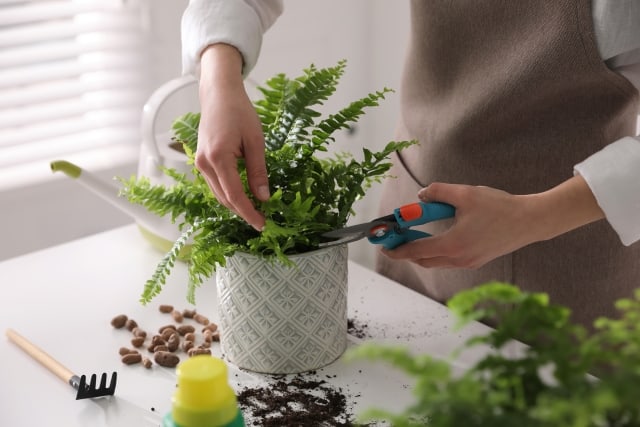
If the fern has been damaged by fungus or pests then the dead fronds should be disposed of carefully, by burning or in household waste, to prevent the spread of disease. Otherwise, fronds can be composted.
This method of pruning helps to stimulate new growth, and reinvigorates the fern.
Routine maintenance
Trimming back occasional brown fronds can be a routine part of fern care, and for indoor plants this is an ongoing practice until the plant becomes pot bound and needs to be divided or repotted.
For outdoor ferns, many growers are more bold in their annual maintenance. In late winter or early spring, before the new growth begins to appear, the previous year’s foliage is pruned back hard, down to the crown of the roots. This can even be done for evergreen ferns that are still in full display – clearing all the old fronds away and leaving little more than a spiky hedgehog-like crown above the earth. Here’s a good demo from the Howell group:
Although it seems severe, this pruning practice leads to an exuberant burst of growth in the spring, as new fiddleheads emerge to replace the lost fronds. This maintenance regime is not necessary if you are still enjoying the evergreen color in an otherwise dreary season, but it does guarantee a vigorous and spectacular display through the coming spring and summer.
While there are many potential causes of brown fronds in ferns, most can be managed with simple steps. Cutting them back is good for the plant, and keeps it looking at its best.
